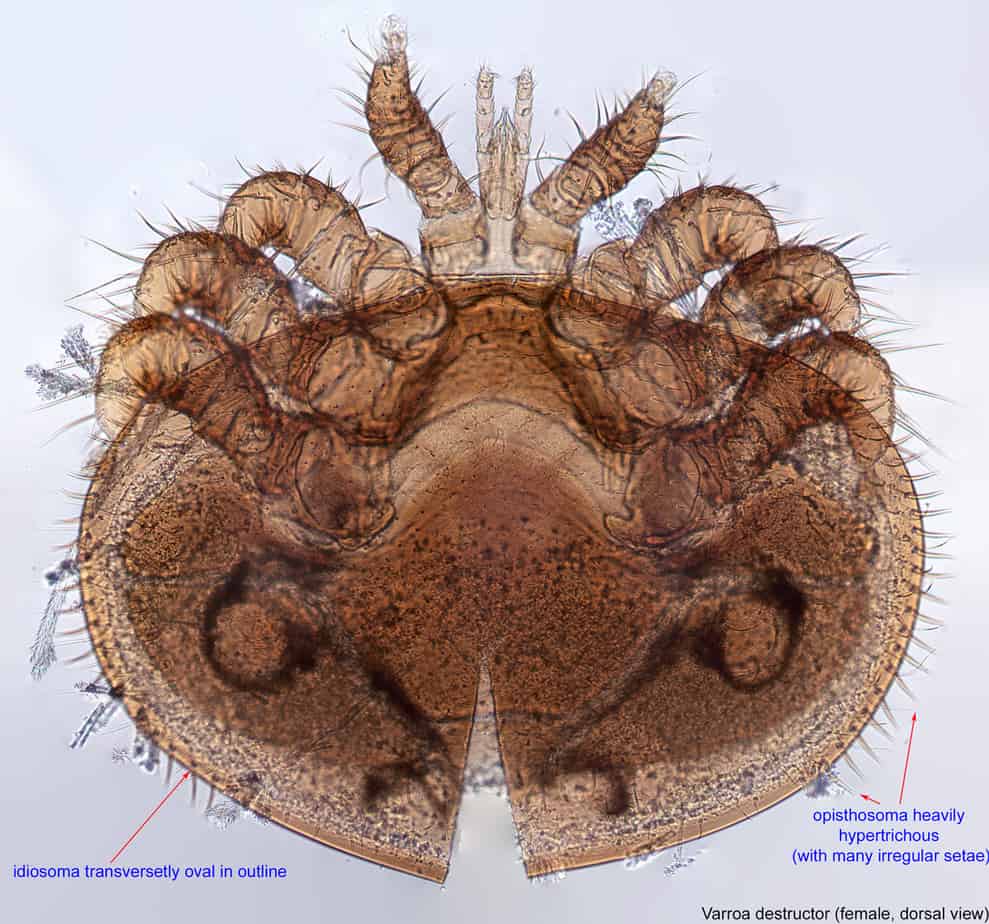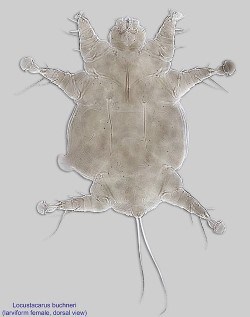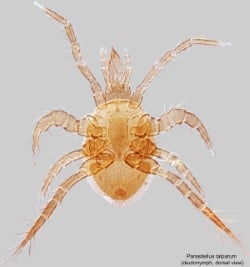Table of Contents
Mites? On Bumblebees?
When we think of mites generally we think of the kinds that cause problems for us. You know, dust mites, bed bugs, and the like. Did you know that Bumblebees actually can suffer from an assortment of mites as well too? It sounds strange, but it’s true. Parasitic mites such as Varroa Destructor, Locustacarus Buchneri, and Parasitellus Fucorum all pose a big threat to the health of Bumblebees.
The Varroa Destructor mite can be especially dangerous due to existing in a symbiotic relationship with Deformed Wing Virus (DWV), allowing the virus to spread in bee colonies and ravage their immune system. There is a way you can actually help Bumblebees to combat these mites, however! This article will go into detail about how your contributions can help Bumblebees combat mites through ways ranging from chemicals to biologic (natural) methods, and even one type of mite you can help Bumblebees no longer suffer from by assisting them with a fine-tooth comb!
First, let’s break-down the three most notable mites and why they are so dangerous to Bumblebees.
Varroa Destructor Mite

The Varroa Destructor mite is a huge concern for Honeybees and Bumblebees. It was first introduced to Florida sometime in the late 1980s or early 1990s (the exact date is unclear). It attaches itself to bees when they land near where it is hidden (such as on flowers) and it survives by sucking the blood the bees, weakening them over time. What is especially dangerous, is how Varroa Destructor can serve as a, “Vector,” AKA carrier for the earlier-mentioned Deformed Wing Virus.
See our other post of diseases: https://schoolofbees.com/do-bees-carry-diseases/
It carries the virus in its body without being hurt, but when it feeds on the bees it transfers DWV to them. The virus is then passed along by drone bees (males) who mate with the queen and then an infected queen gives birth to bees with missing or deformed wings. These bees are even less able to combat the Varroa Destructor mite so it easily feeds on them as well. This symbiotic relationship between Varroa Destructor and DWV serves as a deadly loop for Honeybees and Bumblebees which find themselves eventually suffering a colony collapse in worst-case scenarios.
Professional Bee-breeders have been working at trying to “Toughen-up” bees so that they have a better ability to combat Varroa Destructor, but the DWV it carries is in some ways even more dangerous than the mite. Catching a case of Varroa Destructor mites early on is often key, before the mites and/or DWV can spread too much within a colony. Varroa Destructor is without a doubt a major mite to be cautious about with Bumblebees due to how the mite itself is a risk and the DWV it carries is such a danger.
Locustacarus Buchneri

This parasitic mite happens within Bumblebees’ tracheae and air sacs, so it is not seen “on” Bumblebees due to occurring inside them. They feast on the pollen grains within the Bumblebees’ tracheae. These mites do not harm the bees themselves in terms of how they don’t feast on the Bumblebee’s blood or anything like that. However, they can be a problem in that Locustacarus Buchneri can lead to diarrhea in bees or cause lethargy that results in them not foraging.
While Locustacarus Buchneri can serve as a problem, but it is not as big a worry as Varroa Destructor. There has been an effort to study if Locustacarus Buchneri could be useful in combatting Varroa Destructor, serving as a biologic defense (male Locustacarus Buchneri mites attack Varroa Destructor mites) instead of using pesticides. Still, having no mites is better than even having just Locustacarus Buchneri.
Parasitellus Fucorum

It is easy to spot Parasitellus Fucorum on Bumblebees as they look like big light-orange splotches. Parasitellus Fucorum likes to live in nests because of how they feed upon excess wax and pollen found there. Being infested with too many of these mites can cause the bees to be too heavy and then have trouble flying or get lethargic.
Parasitellus Fucorum is not really a true parasite when it comes to Bumblebee’s as it generally does not directly harm them/that is not its intent. It just wants to use Bumblebees as the method of transport to get to a big hive and then feast upon all the extra wax and pollen. Generally, a small number of Parasitellus Fucorum on Bumblebees is not a cause for too much concern. However, an excessive number on an individual bee can be a big issue. Around 80 is a lot, for example, and one time 165 were recorded on just one bee!
How You Can Get Mites Off Bumblebees
Depending on the kind of mite a Bumblebee may be suffering from, there are different actions that should be taken. For example, the more dangerous Varroa Destructor (with the fact it can transmit DWV) has different steps to be taken than Parasitellus Fucorum. Also, as Locustacarus Buchneri occurs internally there is not really any way to assist Bumblebees with that, so it won’t be addressed further. However, read on for advice regarding dealing with Varroa Destructor and Parasitellus Fucorum!
Helping Bumblebees Suffering From Varroa Destructor Mites
When it comes to trying to help Bumblebees (and Honeybees) that have the nasty Varroa Destructor mites afflicting them, there are many options you can try to help them ranging from biologic/natural to using certain chemicals and pesticides, or in the case of pesticides that kill mites, miticides. One popular miticide is Apistan. A plastic strip that rubs onto bees and gets into their bloodstream, it can make their blood poisonous to Varroa Destructor mites (and contaminates honey in the process of being made with Honeybees so be aware of that). CheckMite+ is another chemical strip that can work well, especially if dealing with Varroa Destructor Mites that has developed a resistance to Apistan.
Other chemical treatment options exist, but can be more difficult to use or they can really harm bees. Mite Away II consists of Formic Acid and Apiguard is a gel that works well if you carefully administer it (don’t use too much). Besides these chemical methods, it can be smart to try natural remedies as well. As these mites prefer to feast on male bees (Drones) you can make a specialized drone cone that captures drones. Then these drones can be humanely disposed of (such as via freezing them) with the process repeated until any drones who appear to be infected are out of the colony.
Lastly, one method for Varroa Destructor mite control that sometimes is brought-up has backers and detractors. There is much debate about a “powdered sugar” method. Some believe it works wonders and others argue it is useless for Varroa Destructor mites. The idea is dusting the bees with can kill the mites, but results seem to vary. Those who argue in favor of or against this method tend to at least agree it should be used along with other ways of trying to stop Varroa Destructor mites and not as the sole solution.
Getting Parasitellus Fucorum Off Bumblebees
Compared to Varroa Destructor and how it both dangerous to Bumblebees and a bit difficult to get rid of, Parasitellus Fucorum is comparatively a good deal easier to handle. Basically getting the Bumblebee wet can cause the mites to be loosened or even drop/jump off. A Bumblebee that is overcome with Parasitellus Fucorum can find itself a lot lighter if it is gently placed in a small puddle of water (such as in a spoon) or even if it is gingerly “dunked” into a slightly larger pool of water.
If you have an extremely fine-tooth comb and a patient Bumblebee it is possible to carefully run the comb along it and have the mites further loosen-up and come-off. The mites will pose no risk to you (e.g. they won’t bite you) so don’t worry about that. It is not so much you need to get all the Parasitellus Fucorum off of a Bumblebee, but if you can help one covered in this mite reduce the number crawling along it to even some degree, that will surely make the Bumblebee pleased!
Try to Keep Those Bumblebees Mite-Free
It is now clear that Bumblebees face a variety of mites. Some of these mites are less of a concern for the Bumblebees than others, even though zero mites would be optimal. The danger arises when these mites cause the bees to develop potentially hive-destroying viruses or weigh the bees down so much they struggle to forage or fly. By being aware of the signs that Bumblebees may be afflicted with mites you can be prepared to help them address the problem via chemicals, biologic/natural methods, or just giving them a good combing with a fine-tooth comb. Thanks to this article you now have some tips on how to help Bumblebees afflicted with mites and you possibly will make a Bumblebee in need very happy someday thanks to your knowledge!
Sources
https://www.pnas.org/content/113/12/3203
https://www.bedbugsbites.net/do-i-have-dust-mite-bites-or-bed-bug-bites/
https://www.sciencemag.org/news/2019/07/breeders-toughen-bees-resist-deadly-mites
https://entomology.ca.uky.edu/ef608
http://idtools.org/id/mites/beemites/factsheet.php?name=15282
https://www.nature.com/news/1999/990701/full/news990701-13.html
https://www.jenskjeld.info/artikler/The_bumblebee_mite_Parasitellus_fucorum_De%20Geer_1778.pdf
